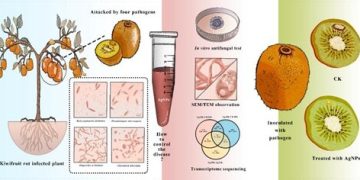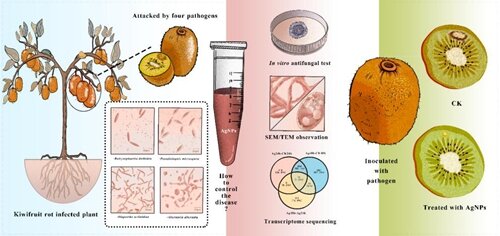Kiwifruit is popular with consumers due to its unique flavor and high concentration of vitamin C, minerals, and other nutrients. As demand grows and the kiwifruit producing area in China expands, post-harvest rot diseases become more severe, with the average infected rate reaching 30%–50%, causing more than 100,000 tons of fruit losses per year, which seriously limits the industry’s healthy development.
Researchers from the Wuhan Botanical Garden of the Chinese Academy of Sciences evaluated the antifungal activity and mechanism of silver nanoparticles (AgNPs) against four pathogens (Alternaria alternata, Pestalotiopsis microspora, Diaporthe actinidiae, and Botryosphaeria dothidea) causing kiwifruit post-harvest rot.
They found that AgNPs had distinct inhibitory effects on the mycelial growth and spore germination of the four pathogens. It increased the permeability of cell membrane and leakage of intracellular substance, and caused cellular and organelle structural degradation. Moreover, transcriptome sequencing of mycelium treated with AgNPs (24h/ 48h) was performed to reveal the molecular mechanism.
According to the researchers, AgNPs remarkably reduced the infected phenotype and fluorescence symptoms, as well as the pathogen colonization and disease development of kiwifruit post-harvest rot with few Ag+ residue in the fruit’s peel or inner/ external pulp, indicating that AgNPs treatment was safe for kiwifruit.
The researchers verified that AgNPs could be used to control kiwifruit rot disease, and laid the groundwork for the application of AgNPs to control other fruit fungal diseases.
Results of this study have been published in Frontiers in Microbiology, titled “The antifungal activity and mechanism of silver nanoparticles against four pathogens causing kiwifruit post-harvest rot.”































